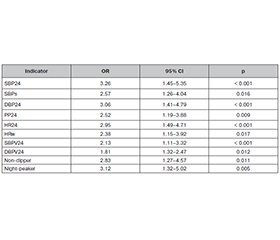Международный неврологический журнал Том 20, №1, 2024
Вернуться к номеру
Особливості добового профілю артеріального тиску та серцевої діяльності в пацієнтів з аритміями залежно від вираженості когнітивних розладів
Авторы: S.M. Stadnik (1), O.M. Radchenko (2)
(1) - Military Medical Clinical Center of the Western Region, Lviv, Ukraine
(2) - Danylo Halytsky Lviv National Medical University, Lviv, Ukraine
Рубрики: Неврология
Разделы: Клинические исследования
Версия для печати
Актуальність. Мета: встановити залежності змін когнітивної сфери від особливостей добового профілю артеріального тиску (АТ) та серцевої діяльності в пацієнтів з аритміями. Матеріал та методи. Обстежено 139 пацієнтів із різними клінічними формами аритмій. Проводили розширене нейропсихологічне тестування, дослідження добового профілю АТ та серцевої діяльності всіх учасників. Стан гемодинаміки оцінювали шляхом добового моніторування АТ і електрокардіографії. Вивчали середньодобові, середньоденні і середньонічні значення систолічного (САТ), діастолічного артеріального тиску (ДАТ) і частоти серцевих скорочень (ЧСС). Для оцінки стану вегетативної нервової системи використовували аналіз спектральних показників варіабельності серцевого ритму. Визначали зв’язки гемодинамічних показників із результатами нейропсихологічного тестування. Результати. У пацієнтів із когнітивними розладами (КР) мало місце підвищення САТ у всі періоди доби, найбільш виражене в осіб із помірними КР (p = 0,049). В учасників із легкими КР і без КР не виявлено вірогідних міжгрупових відмінностей за рівнем середньодобових, середньоденних та середньонічних САТ, ДАТ і пульсового тиску (р > 0,05). У пацієнтів із помірними КР визначали вірогідно вищі САТ та індекс часу САТ за рахунок їх середньоденних і середньонічних значень порівняно з особами без КР (р < 0,05). В активний період доби індекс часу ДАТ був вірогідно вищим у хворих із помірними КР (р = 0,002), у яких також зареєстровано підвищення варіабельності САТ за добу, день і ніч порівняно з пацієнтами без КР (р = 0,041). За показниками варіабельності ДАТ відмінності між групами були невірогідні (р = 0,07). У 61 (54 %) пацієнта з КР у структурі порушень добового профілю АТ переважав non-dipper САТ, з найбільшими показниками при помірних КР (55,6 %). За нормальними показниками добового індексу ДАТ приховано наявність у пацієнтів із КР несприятливих добових профілів АТ — night-peaker (6,2 %) і over-dipper (8,8 %), які переважали при помірних КР. Підвищені показники середньодобових САТ (співвідношення шансів (СШ): 3,26, 95% довірчий інтервал (ДІ): 1,45–5,35, p < 0,001), ДАТ (СШ: 3,06, 95% ДІ: 1,41–4,79, p < 0,001), середньодобової ЧСС (СШ: 2,67, 95% ДІ: 1,32–4,14, p < 0,001), середньодобової варіабельності САТ (СШ: 2,13, 95% ДІ: 1,11–3,32, p < 0,001) є основними чинниками порушення гемодинаміки, що збільшують ризик розвитку КР у пацієнтів з аритміями. Висновки. Виявлені асоціації когнітивної дисфункції і показників добового моніторування АТ та серцевої діяльності важливі в контексті їх комплексного обліку для оптимізації індивідуалізованого підходу до ведення пацієнтів і прогнозування розвитку КР.
Background. The purpose of our work was to reveal the dependence of changes in the cognitive sphere on the peculiarities of the daily profile of blood pressure (BP) and heart activity in patients with arrhythmias. Materials and methods. We examined 139 patients with different clinical forms of arrhythmias. All of them underwent extended neuropsychological testing, a study of the daily BP profile and heart activity. Hemodynamic status was assessed by daily BP and ECG monitoring. Average daily, average daytime and nighttime systolic (SBP), diastolic blood pressure (DBP) and heart rate (HR) were evaluated. The analysis of spectral indicators of heart rate variability was performed to assess the state of the autonomic nervous system. Correlations of hemodynamic indicators with the results of neuropsychological testing were determined. Results. In patients with cognitive disorders (CD), there was an increase in SBP in all periods of the day, most pronounced in patients with moderate CD (p = 0.049). In patients with mild CD and without CD, there were no significant intergroup differences in the level of average daily, daytime and night SBP, DBP and pulse pressure (p > 0.05). Patients with moderate CD had significantly higher SBP and time index of SBP at the expense of average daytime and average night values of these indicators compared to those without CD (p < 0.05). During the active period of the day, time index of DBP was significantly higher in patients with moderate CD (p = 0.002) who also had an increase in average daily, daytime and night SBP variability compared to participants without CD (p = 0.041). The differences between the groups were not significant in terms of DBP variability (р = 0.07). In 61 (54 %) patients with CD, non-dipper SBP prevailed in the structure of disorders of the daily BP profile, with the highest indicators in moderate CD (55.6 %). The presence of adverse daily DBP profiles — night-peaker (6.2 %) and over-dipper (8.8 %), which prevailed in patients with moderate CD, is hidden behind normal indicators of the daily BP index. Increased average SBP24 (odds ratio (OR) = 3.26, 95% confidence interval (CI): 1.45–5.35, p < 0.001), DBP24 (OR = 3.06, 95% CI: 1.41–4.79, p < 0.001), average HR24 (OR = 2.67, 95% CI: 1.32–4.14, p < 0.001), average SBP24 variability (OR = 2.13, 95% CI: 1.11–3.32, p < 0.001) are the main factors of central hemodynamic disorders that increase the risk of developing CD in patients with arrhythmias. Conclusions. The identified associations between cognitive dysfunction, indicators of daily BP monitoring and heart activity are important in the context of their comprehensive accounting for optimizing an individualized approach to patient management and predicting the development of CD.
аритмії; когнітивні розлади; добове моніторування артеріального тиску; варіабельність серцевого ритму
arrhythmias; cognitive disorders; daily blood pressure monitoring; heart rate variability

